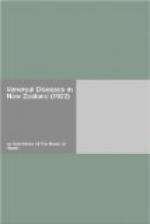The investigations of the Committee show that already there is far too large a proportion of mental and physical defectives reproducing their kind. In the absence of accurate statistics it is impossible to say what proportion of these defectives are the direct product of venereal disease, but there is clear evidence that a tendency to lead dissolute lives is especially noticeable in the females belonging to this unfortunate class. “A feeble-minded girl,” says Mr. Beck, “has not sense enough to protect herself from the perils to which women are subjected. Often amiable in disposition and physically attractive, they either marry and bring forth a new generation of defectives, or they become irresponsible sources of corruption and debauchery in the communities where they live.” Obviously some method of dealing with mental defectives—by segregation or otherwise—must be found as part of the problem of dealing with venereal disease.
As regards the effect of venereal disease on the general health of the community, we have the statement of the late Sir William Osler that he regards syphilis as “third on the list of killing diseases”; while Neisser, a leading authority, says that “with the exception of measles, gonorrhoea is the most widely spread of all diseases. It is the most potent factor in the production of involuntary race suicide, and by sterilization and abortion does more to depopulate the country than does any other cause.”
In view of the facts brought out in the course of the inquiry, the Committee are strongly of opinion that it would be criminal neglect to allow the evil to go on without taking energetic steps to check its ravages. They believe that the legislative and other measures which they recommend for the medical prevention and treatment of venereal disease will, if given effect to with the loyal co-operation of the medical profession, have a very beneficial result in reducing the prevalence of disease, and will save an incalculable amount of sorrow and suffering which in too many cases falls upon the innocent. In what is proposed in this report there is nothing approaching a revival of the old Contagious Diseases Acts. To use the words of Dr. Emily Seideberg, the principle of the legislation now proposed is “To improve the health of the community, and not, as in the old Contagious Diseases Acts, to make sexual immorality safe for men of low morals.”
The Committee are of opinion that, far from conditional notification and compulsory treatment on the lines proposed being prejudicial to woman in any way, it is they who will reap the greatest benefit from these measures. In fact, sufferers from venereal disease, as a whole, have everything to gain and nothing to lose so long as they will continue under treatment, and to enable them to do this the best medical skill is placed at their disposal free of cost. The only persons in the community who will be penalized by the proposed legislation are those who, having contracted venereal disease, are so reckless and unprincipled that they will take no pains to avoid communicating it to others.




